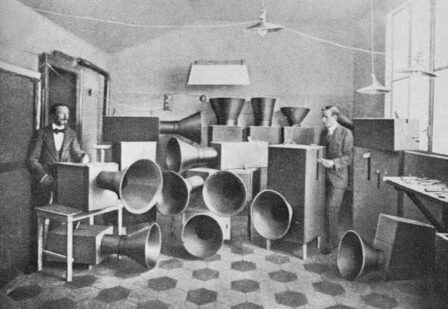Centenary of The Art of Noises
Instead of referring to the most up to date in sound art, today we pay homage to a text and to an artist that had an essential impact on this subject. Last week we celebrated one hundredth anniversary of the publication of The Art of Noises, a letter-manifesto by italian futurist painter Luigi Russolo that has a fundamental importance in almost all thought about noise, techno and sound art ever since.
In his text , dated from 1913, Russolo points that the orchestras and the music that was produced at that time were both boring and not adequate to the sensibility of that time (i. e., the sensibility of the futurist artist) – from his point of view, young composers should embrace and bring the speed and the noises of the machines from urban environments to their music. He suggests opening up their vocabulary to these noises and creates a system to organize them, coming ahead to Pierre Schaeffer’s Solfège des objets sonores, and sets out to write concerts for the noise-generating instruments built by himself, the intonarumori. Actually, the radical nature of his thinking lies in the fact of propounding a change in the way we hear and think about music itself.
Russolo and his intonarumori, pictured with Ugo Piatti]
Much has been said about Russolo, whose scores and recordings were virtually destroyed in between two world wars, and we could never address it fully here. Besides, the very concept of “noise” is a complicated one [http://www.guardian.co.uk/music/2008/nov/10/squarepusher-paul-hegarty-noise] in itself and in its relations with music (take, for instance, the amount of people that call their own music noise nowadays). Nevertheless, Russolo’s vision of the future is particularly interesting to me: he believed that the day we achieve a musical sensibility akin to our time and the tools to make it real, “the engines of our industrial cities will be skillfully tuned so that every factory is turned into an intoxicating orchestra of noises”.
One needs only a glimpse at the music that’s being recorded nowadays, and at the amount of urban field recordings / soundscapes being produced to realize that, since the last hundred years, we have already changed our sensibility to some extent. I also believe that we are already “tuning our engines” as he predicted (as an example, see the problem with electric cars [http://www.bbc.co.uk/news/technology-16126982]: the car industry now invites pop music producers to create artificial sounds for their engines, because silent cars are too dangerous to people in the streets). It seems we’re not that far away from the futurist dream after all.
As a takeaway, here we can find a recording [https://soundcloud.com/artofnoises/manifesto-1913/], recently unveiled, of what is allegedly Russolo reading his own manifesto. Still, one question keeps haunting me: if we now accept everything we used to call noise in our music and in sound art, where are we heading to in the next one hundred years?.
Felipe Vaz.
Categories: Audio Formal's blog |


